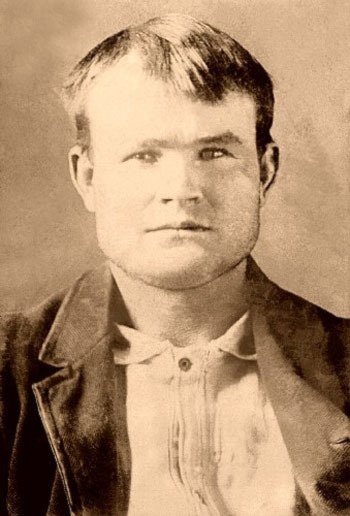To the ten or twelve kids who attended Nixon Creek School (Caycuse) in the 1930s, old Charlie Mott was of great interest.
A bit of a recluse, the tall thin man with a drooping handlebar mustache lived in a small cabin on the far side of the bank of nearby Nixon Creek.
Ocasionally Mott would appear in camp (Caycuse) “to pick up a few groceries and his mail,” recalled Margaret McGowan (nee Norman) many years later. Occasionally, he would visit Margaret’s dad Henry Norman, with the two “sitting at the kitchen table talking quietly for hours on end.” Part of the allure of the mysterious Charlie Mott was the subtle and persistent rumor that he had once been a “gunman and train robber in the American West – perhaps the infamous Butch Cassidy?”
Mott was guardedly fond of the school children and on occasion would invite them all to supper; usually a Friday night. When the much-anticipated day came, and with permission from their parents, the kids would “go whooping off down the trail to Nixon Creek.” In his rowboat – which he kept tied to a stake just below his cabin – Charlie would be waiting to row them across the deep water to his cabin on the other side.
Once there, the kids delighted in playing with the squirrels that Charlie had tamed, admired the vegetable garden, and “inspected any new and interesting projects that Charlie might have undertaken.”
The next treat was the much anticipated dinner, which was always a thick “mulligan venison stew with fresh garden vegetables and huge slabs of homemade bread slathered with butter,” in quantities enough to feed an army. On other occasions, and if he felt so inclined, he might invite their mothers, known as “the ladies of camp,” over for tea. This was conducted in a much more formal manner (bread and jam served with tea along with polite conversation) than the children’s lively dinners.
Since the camp folks knew that Charlie was “constantly on guard with rifle over his arm,” while anticipating the approach of the occasional stranger on the trail or the beach, they speculated that his invitations to supper and tea was a way to quell unexpected company.
Two of the older camp boys (Rudy and Cyril) liked to visit him and listen to his stories of bank and train robberies and other daring escapades.
Both boys told of seeing “bullet holes [scars] in his shoulder and leg, which he supposedly received in gunfights.”
They boasted that Charlie “had never missed a target” with his rifle.
One day, Rudy entered Mott’s cabin and “surprised him as he napped with rifle beside him.”
In a flash, Mott was on his feet with rifle aimed. “Fortunately, he paused long enough to recognize Rudy before pulling the trigger.”
One suspects that the encounter was broadcast all over camp soon after, which likely helped to discourage any further surprise visitors.
It was said that two days before Charlie’s death in 1937 at the Duncan Hospital, two Pinkerton Detective Agents from the United States arrived at the hospital, having finally tracked down the man they had searched many years for.
Since death was “very near,” Mott’s doctors refused the agents permission to question him.
[NOTE: no record of the 1937 death was found on the BC Archives website. The closest death listed was that of a Charles Wesley Mott on December 28, 1937 in Victoria.]
The residents of Caycuse had often wondered if the mysterious Charlie Mott was actually the legendary bank and train robber Butch Cassidy, who, along with the Sundance Kid, had long been pursued by the same Pinkerton National Detective Agency.
